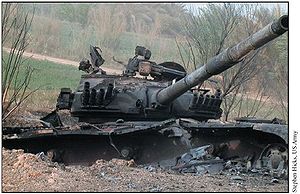.gif)
Battle of the Karbala Gap (2003)
Encyclopedia

2003 invasion of Iraq
The 2003 invasion of Iraq , was the start of the conflict known as the Iraq War, or Operation Iraqi Freedom, in which a combined force of troops from the United States, the United Kingdom, Australia and Poland invaded Iraq and toppled the regime of Saddam Hussein in 21 days of major combat operations...
. The Karbala Gap is a 20-25-mile wide strip of land with the Euphrates River to the east and Lake Razazah to the west. This strip of land was recognized by Iraqi commanders as a key approach to Baghdad
Baghdad
Baghdad is the capital of Iraq, as well as the coterminous Baghdad Governorate. The population of Baghdad in 2011 is approximately 7,216,040...
, and was defended by some of the best units of the Iraqi Republican Guard
Iraqi Republican Guard
The Iraqi Republican Guard was a branch of the Iraqi military during the presidency of Saddam Hussein. It later became the Republican Guard Corps, and then the Republican Guard Forces Command with its expansion into two corps....
. American forces attacked Iraqi forces in the area with massive air attacks followed by concentrated armored thrusts which resulted in the Iraqi units being surrounded and annihilated.
Initial Moves
The Iraqi high command had originally positioned two Republican Guard divisions blocking the Karbala Gap. Here these forces suffered heavy Coalition air attacks. However, the Coalition had since the beginning of March been conducting a strategic deception operation to convince the Iraqis that the US 4th Infantry Division would be mounting a major assault into northern Iraq from Turkey. This deception plan worked, and on April 2 Saddam's son Qusay HusseinQusay Hussein
Qusay Saddam Hussein al-Tikriti was the second son of Iraqi President Saddam Hussein. He was appointed as his father's heir apparent in 2000.- Family :...
declared that the American invasion from the south was a feint and ordered troops to be re-deployed from the Karbala front to the north of Baghdad. Lt. Gen. Raad al-Hamdani, who was in command of the Karbala region, protested this and argued that unless reinforcements were rushed to the Karbala gap immediately to prevent a breach, American troops would reach Baghdad within 48 hours. His suggestions fell on deaf ears.
Meanwhile, American troops were pushing through the gap and reached the Euphrates River at the town of Musayib. An expected Iraqi chemical attack did not materialize. At Musayib, American troops crossed the Euphrates in boats and seized the vital al-Kaed bridge across the Euphrates after Iraqi demolitions teams had failed to destroy it in time. In response, Lt. Gen. Hamdani was ordered to launch an immediate counterattack. Hamdani later said that his units were not in condition to launch an immediate counterattack and that he counseled to establish a defensive line along the Usfiyah River in order to contain the American breakthrough. Nevertheless, Hamdani's forces launched a counterattack on the night of April 2-3.
Iraqi Counterattacks April 2-3
The 10th Armored Brigade from the Medina Division and the 22nd Armored Brigade from the Nebuchadnezzar Division, supported by artillery, launched night attacks against the American bridgehead at Musayib. The attack was savagely repulsed using tank fire and massed artillery rocketsMultiple rocket launcher
A multiple rocket launcher is a type of unguided rocket artillery system. Like other rocket artillery, multiple rocket launchers are less accurate and have a much lower rate of fire than batteries of traditional artillery guns...
, destroying or disabling every Iraqi tank in the assault. The next morning, Coalition aircraft and helicopters rained death on the Republican Guard units, destroying many more vehicles as well as communications infrastructure. The Republican Guard units broke under the massed firepower and lost any sense of command and cohesion. By the end of the day, the tanks of the 3rd ID had overrun Lt. Gen. Hamdani's headquarters and Hamdani and his staff fled. American forces lost no men killed in this action while Iraqi losses are estimated at 230 to 300 killed.
Destruction of the Medina Division
While the fight around Musayib was raging on April 3, other elements of the US 3rd ID had captured Baghdad International AirportBaghdad International Airport
Baghdad International Airport, originally Saddam International Airport, , BIAP is Iraq's largest airport, located in a suburb about west of downtown Baghdad in the Baghdad Governorate...
. Before pushing deeper into Baghdad, US commanders decided to mop up the remnants of the Republican Guard Medina Division which were still present south of Baghdad. The intention was to catch the Medina Division from behind, while they were engaging other units to their front. The 2nd Brigade of the 3rd ID under Col. David Perkins was dispatched to the southwest towards Objective Saints, the codename for the intersection between highways 1 and 8. The interchange was defended by dismounted infantry, and during the fight for Objective Saints one US soldier was wounded and an M1 Abrams tank was disabled by an RPG round (it was later repaired).
After capturing Objective Saints on the 3rd, the 2nd Brigade pushed south and made contact with the remnants of the 10th and 2nd Brigades of the Medina Division. Despite reports that 80% of the division's vehicles had been destroyed, the Iraqis had moved their vehicles away from their prepared defenses and hidden them near buildings and in palm groves, sparing many of them from air attack. Hundreds of Iraqi tanks, IFVs and artillery were still present.
The American tanks tore into the Iraqi vehicles, destroying many of them at point blank range. Despite the survival of many of their vehicles, the Iraqi defense was un-coordinated and many troops put on civilian clothes and deserted during the fight, leaving their uniforms on the battlefield. The Medina Division ceased to exist as an effective fighting force.

